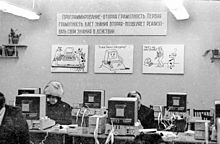| History of computing |
|---|
 |
| Hardware |
| Software |
| Computer science |
| Modern concepts |
| By country |
| Timeline of computing |
| Glossary of computer science |

The history of computing in the Soviet Union began in the late 1940s,[1] when the country began to develop its Small Electronic Calculating Machine (MESM) at the Kiev Institute of Electrotechnology in Feofaniya.[2] Initial ideological opposition to cybernetics in the Soviet Union was overcome by a Khrushchev era policy that encouraged computer production.[3]
By the early 1970s, the uncoordinated work of competing government ministries had left the Soviet computer industry in disarray. Due to lack of common standards for peripherals and lack of digital storage capacity the Soviet Union's technology significantly lagged behind the West's semiconductor industry.[4][5] The Soviet government decided to abandon development of original computer designs and encouraged cloning of existing Western systems (e.g. the 1801 CPU series was scrapped in favor of the PDP-11 ISA by the early 1980s).[4]
Soviet industry was unable to mass-produce computers to acceptable quality standards[6] and locally manufactured copies of Western hardware were unreliable.[7] As personal computers spread to industries and offices in the West, the Soviet Union's technological lag increased.[8]
Nearly all Soviet computer manufacturers ceased operations after the breakup of the Soviet Union.[9] A few companies that survived into 1990s used foreign components and never achieved large production volumes.[9]
- ^ Cite error: The named reference
chmelbr2was invoked but never defined (see the help page). - ^ Cite error: The named reference
harbour99was invoked but never defined (see the help page). - ^ Cite error: The named reference
wilson15was invoked but never defined (see the help page). - ^ a b Cite error: The named reference
rbth14was invoked but never defined (see the help page). - ^ Ichikawa 2006, pp. 18–31.
- ^ Stapleton & Goodman 1988.
- ^ Judy & Clough 1989, pp. 251–330.
- ^ Cite error: The named reference
lat86was invoked but never defined (see the help page). - ^ a b Prokhorov 1999, pp. 4–15.